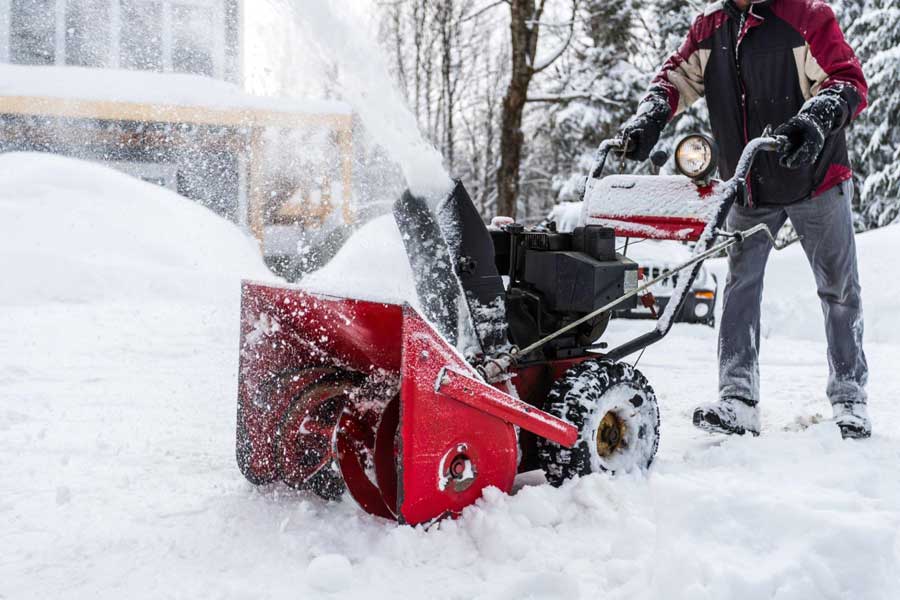Finance
How to Start a Residential Snow Removal Business

Is Snow Removal profitable business? Yes, according to IBISWorld, between 2018 and 2023, the market of Snowplowing Services industry in the US is increased by an average of 3.1% annually with 0.8% increase rate and the market size is expected to reach at $25.6bn in 2023.
[The report can be found here: https://www.ibisworld.com/industry-statistics/market-size/snowplowing-services-united-states/ ]
However, profit of a snow removal business can be varied for a number of factors, like company size, working, service quality etc. Moreover, snow removal business is a kind of seasonal business in some other states in the US.
So, your presence to the article means you are looking for ways to start a residential snow removal business. If my thought is right, this article will answer your all questions that are haunting around your head from A-Z.
This article will include startup costing, profit, equipment your need, and some essential FAQs. Let’s dive into in-depth!
How to Start a Residential Snow Removal Business?
Starting a residential snow removal business is a great profitable business, especially in regions where snowfall is common during the winter months.
By the way, we have another article regarding to the step by step guidelines for a junk removal business, you can visit, where we have discussed about all crucial steps in-depth. Both junk removal business and snow removal business have quite similarities.
However, typically, most steps of beginning a business are quite same except a few. As a result, our discussion will comparatively keep focusing on the most essential related questions and the steps of starting a snow removal business will be in brief.
Here are the steps to get you started:
1. Research and Planning: Start researching the demand for snow removal services in your local area. Look into the competition, the average snowfall, and the potential customer base. It will help you determine if there’s a viable market for your business. Create a comprehensive business plan outlining your goals, target market, services offered, pricing, and marketing strategies.
2. Legal Considerations and Insurance: Register your business and obtain any necessary licenses or permits required in your area. Consider forming a legal business entity, such as an LLC, to protect your personal assets.
3. Equipment and Supplies: Invest in the right snow removal equipment, such as snow blowers, plows, shovels, salt spreaders, safety gear, etc.
4. Service Offerings: Determine the range of services you’ll provide, such as driveway plowing, sidewalk clearing, de-icing, and more. Tailor your offerings to meet the needs of your target customers.
5. Pricing Strategy: Set competitive yet profitable pricing for your services. Consider factors like the size of the area to be cleared, the frequency of service, and the level of snowfall.
6. Marketing and Branding: Create a professional brand identity, including a business name, logo, and website. Utilize online and offline marketing strategies to reach potential customers. This could include social media promotion, local advertising, flyers, and word-of-mouth.
7. Safety and Regulations: Prioritize safety for both your team and your customers. Follow all local regulations for snow removal and disposal. Make sure your team is aware of safe practices to prevent accidents during snow clearing operations.
8. Continuous Improvement: Gather feedback from your customers and use it to improve your services. Adapt to changing needs and market conditions, and continuously refine your business strategies.
You May Also Like it:
20 Weird Business Ideas That Made Millions: Embracing Unconventional Paths to Success
Dump Trailer Business Ideas: How to Make Money with a Dump Trailer
How much Does It Cost to Start a Snow Plow Business?

Starting a snow plow business involves several factors that contribute to the overall cost. These costs can vary widely based on factors such as location, scale of operation, equipment choices, and more.
Below is a detailed breakdown of potential costs associated with starting a snow plow business:
1. Initial Setup Costs:
- Business Registration and Licensing: This includes fees for registering your business name, obtaining necessary permits, and any legal requirements in your area.
- Insurance: Liability insurance, commercial vehicle insurance, and workers’ compensation insurance are essential to protect your business from potential risks and accidents.
- Business Plan Development: If you choose to create a detailed business plan, there might be costs associated with consulting services or software tools.
2. Equipment Costs:
- Snow Plow Trucks: The cost of snow plow trucks varies based on the size, brand, and features. Used trucks can be more budget-friendly compared to new ones.
- Plow Attachments: The snow plow attachments that go on the trucks also vary in cost depending on the size and quality.
- Salt Spreaders: If you plan to offer de-icing services, you’ll need salt spreaders. Their cost depends on the size and features.
3. Maintenance and Repairs:
- Regular Maintenance: Snow plow trucks require regular maintenance to ensure they function properly during winter. This includes oil changes, tire rotations, and other upkeep.
- Repairs: Budget for unexpected repairs that might arise during the plowing season.
4. Personnel Costs:
- Employee Wages: If you plan to hire drivers and workers, factor in their wages. Pay might vary based on experience and location.
- Training Costs: Training your employees on safe and efficient snow plowing techniques can incur additional costs.
5. Marketing and Advertising:
- Website Development: Creating a professional website helps market your services. Costs include domain registration, hosting, and possibly web development fees.
- Online Advertising: Budget for online ads and social media campaigns to reach potential clients.
- Printed Materials: Design and printing costs for business cards, flyers, and other promotional materials.
6. Operational Costs:
- Fuel: Estimate fuel costs for your trucks during the plowing season.
- Salt and De-Icing Materials: If you offer de-icing services, include the cost of salt or other de-icing materials.
Costing Breakdown Table:
| Expense Category | Estimated Cost Range |
| Initial Setup | $1,000 – $5,000 |
| Equipment | $20,000 – $50,000 |
| Maintenance and Repairs | $2,000 – $5,000 |
| Personnel | $10,000 – $30,000/year |
| Marketing and Advertising | $1,000 – $5,000 |
| Operational Costs | $1,000 – $3,000/month |
| Total Estimated Cost | $35,000 – $98,000 |
Remember, these are rough estimates and costs can vary significantly.
Pros and Cons of a Snow Removal Business:
Every business has pros and cons, so do snow removal business have. So, before starting a snow removal business, it’s essential to consider pros and cons for the sake of your investment. Here we have included several pros and cons:
| Pros | Cons |
| High demand | Seasonal business |
| Recurring revenue | Weather-dependent |
| Low startup costs if you have trucks | Equipment maintenance |
| Flexible schedule | Competition |
| Simple business model | N/A |
How much is The Snow Plowing Business Profit in The US?
In earlier of this article, we have mentioned the snowplowing market is increased by an average of 3.1% per year in the US.
However, there are many factors need to be considered while determining the profit of snow plowing business, including the size of the business, the amount of snow in the area, and the prices charged. In addition, snow plowing is a seasonal business. This business is a lucrative in those areas where snow fall is common.
According to a study by Small Business Trends, they said –
“Also importantly, snow plowing is a $19 billion a year industry! And it’s a scalable business, too. It can be just a means of adding a few extra bucks to the coffers or something much bigger than that.”
Moreover, we have another survey by Verified Market Research about truck market size for snowplows in the US and Canada, where they stated the truck market size for snowplowing business in the US and Canada was worth $387.8 million in 2019 and is expected to reach $514.3 million by 2027. This growth represents a 3.92% annual increase from 2020 to 2027.
[You can check the report here: https://www.verifiedmarketresearch.com/product/us-canada-snowplows-for-trucks-market/ ]
Do I Need A Business License To Plow Snow?
The licensing requirements for plowing snow vary depending on the state and local regulations. Here are some general guidelines based on the search results:
- Business License: Nearly every business in the United States must have a business license. Some states may require a specific license for snow removal businesses.
- Commercial Vehicle License: In some states, the plow vehicle will need to be registered and licensed as a commercial vehicle.
- Driver’s License: Before getting started, driver’s license is essential that you need. Most states require a valid driver’s license to become a snowplow operator.
- Commercial Driver’s License (CDL): Some states require snowplow operators on the state system to carry a Commercial Driver’s License (CDL).
- Permit: Some cities or municipalities may require a permit to provide private snow plow service.
It is important to check with your state and local government to determine the specific licensing requirements for plowing snow in your area.
Reference link here:
https://legisarchive.nashville.gov/mc/ordinances/term_2015_2019/bl2016_206.htm https://www.indeed.com/career-advice/finding-a-job/how-to-become-snowplow-operator
What Equipment Needed For Snow Removal Business?

The specific equipment needed for a snow removal business will vary depending on the size and scope of the business, as well as the climate and terrain in which it operates. However, some of the most common pieces of equipment used in snow removal businesses include:
| Equipment Names | Details |
| Trucks | Trucks are often used to transport snow removal equipment and to haul away snow that has been removed. |
| Plows | Snow plows are used to clear snow from roads, driveways, and walkways. They can be attached to trucks, tractors, or skid-steer loaders. |
| Snow blowers | Snow blowers are used to clear snow from driveways, walkways, and patios. They are either in electric or gas-powered. |
| Salt spreaders | Salt spreaders are used to spread salt or sand on icy surfaces to prevent slips and falls. They can be attached to trucks or towed behind vehicles. |
| Shovels | Shovels are a basic but essential tool for snow removal. They can be used to clear snow from small areas, such as steps or sidewalks. |
| Roof rakes | Roof rakes are used to remove snow from the roofs of buildings to prevent damage from excess weight. |
| Ice scrapers | Ice scrapers are handheld tools used to remove ice from windshields, sidewalks, and other surfaces. |
| Ice melt | Ice melt is a chemical that is used to melt ice and snow. It can be used in conjunction with salt spreaders or applied directly to icy surfaces. |
| Skid steers | Skid steers are versatile machines that can be used for a variety of tasks, including snow removal. They can be equipped with attachments such as snow blades, snow V-blades, angle brooms, push brooms, snow blowers, scrapers, and snow buckets. |
| Telehandlers | Telehandlers are similar to skid steers but have a telescoping boom that allows them to reach higher areas. They can be used for snow removal tasks such as clearing snow from roofs and other elevated surfaces. |
| Tractors | Tractors are also a popular choice for snow removal. They are more powerful than trucks and can clear snow more quickly. |
Frequently Asked Questions (FAQs)
How do you start a snow removal side hustle?
You start a snow removal side hustle by obtaining necessary equipment, setting competitive pricing, promoting your services locally, and ensuring safety measures.
Is snow blowing a good business?
Yes, snow blowing can be a profitable business, especially in areas with heavy snowfall during the winter months.
How much does a snow plow business make?
The earnings of a snow plow business can vary widely depending on factors such as location, size of the business, and the amount of snowfall in a given year. On average, a snow plow business can make anywhere from $30,000 to $100,000 or more annually.
How do I budget for snow removal?
To budget for snow removal, estimate around $30 to $50 per plow visit or push. For each inch of snow, plan for $60 to $95, with an extra $30 for every additional 6 inches.
Is snow removal hard work?
Yes, snow removal can be hard work due to the draining nature of the job, long hours, and varying amounts of snowfall over time.
Wrapping Up:
So, to conclude, how to start a residential snow removal business? For starting a snow removal business, there are a number of steps, including research and planning, legal considerations, insurance, equipment, marketing and branding, and pricing strategy. All of these factors are crucial to consider.
Before beginning your snow removal business, we recommend to do market research in the places where you are going to provide your services. This will help to determine the demand of your service.
Moreover, pros and cons of your business needs to keep in mind during starting the business because knowing the pros and cons helps you to decide whether you should invest or not.


















